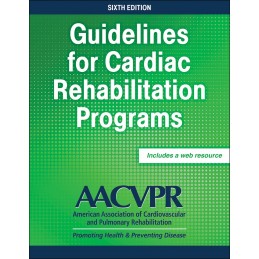Guidelines for Cardiac Rehabilitation Programs, Sixth Edition With Web Resource, presents the combined expertise of more than 50 leaders in the field of cardiac rehabilitation (CR), reimbursement, and public policy to empower professionals to successfully implement new CR programs or improve existing ones. Developed by the American Association of Cardiovascular and Pulmonary Rehabilitation (AACVPR), this guidebook offers procedures for providing patients with low-cost, high-quality programming that moves them toward a lifelong commitment to disease management and secondary prevention.
Cardiovascular disease (CVD) is the principal cause of death worldwide. It is projected that by 2035, more than 130 million adults in the United States will have CVD. The challenge to CR professionals is to select, develop, and deliver appropriate rehabilitative and secondary prevention services to each patient tailored to their individual needs.
Guidelines for Cardiac Rehabilitation Programs, Sixth Edition, is the definitive resource for developing inpatient and outpatient cardiac rehabilitation programs.
The sixth edition of
Guidelines for Cardiac Rehabilitation Programs equips professionals with current scientific and evidence-based models for designing and updating rehabilitation programs. Pedagogical aides such as chapter objectives, bottom line sections, summaries, and sidebars present technical information in an easy-to-follow format. Key features of the sixth edition include the following::
- A new chapter on physical activity and exercise that helps readers understand how to develop and implement exercise programs to CVD patients
- A new chapter on cardiac disease populations that offers readers a deeper understanding of CVD populations, including those with heart valve replacement or repair surgery, left ventricular assist devices, heart transplant, dysrhythmias, and/or peripheral artery disease
- Case studies and discussion questions that challenge readers to consider how concepts from the text apply to real-life scenarios
- An expanded web resource that includes ready-to-use forms, charts, checklists, and logs that are practical for daily use, as well as additional case studies and review questions
Keeping up with change is a professional necessity and keeping up with the science is a professional responsibility.
Guidelines for Cardiac Rehabilitation Programs, Sixth Edition, covers the entire scope of practice for CR programs and professionals, providing evidence-based information on promoting positive lifestyle behavior patterns, reducing risk factors for disease progression, and lessening the impact of CVD on quality of life, morbidity, and mortality.
Note:: The web resource is included with all new print books and some digital versions. For digital version formats that dont provide access, the web resource is available separately.




 Delivery policy
Delivery policy
 Security policy
Security policy
 Return policy
Return policy
